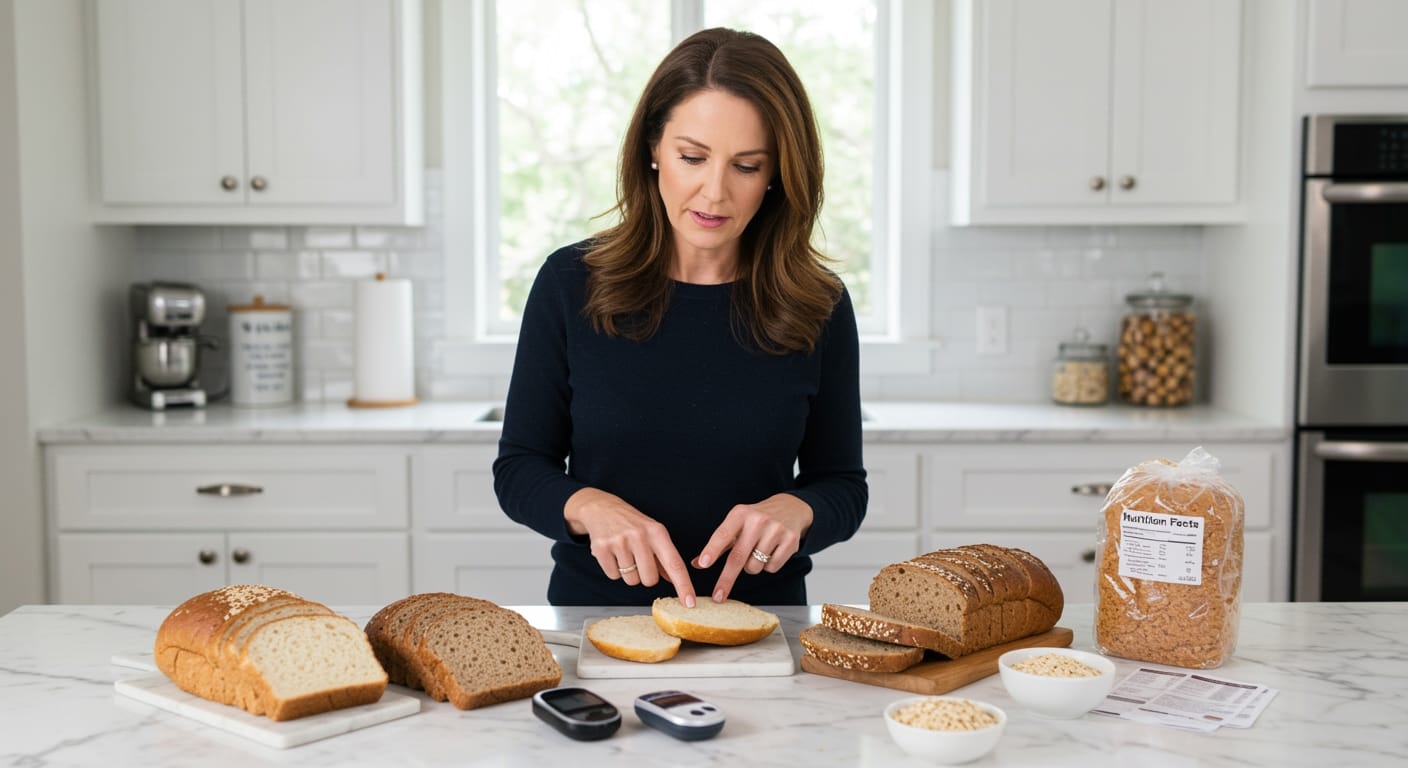✪ Key Takeaway: Diabetics can eat bread by choosing whole grain, high-fiber options and controlling portions to maintain stable blood sugar levels.
Introduction
Your doctor just told you that you have diabetes, and suddenly bread feels like your enemy.
You might be wondering if you need to say goodbye to sandwiches, toast, and all those comforting carbs forever because everyone seems to have a different opinion about bread and diabetes.
Hi, I’m Abdur, your nutrition coach, and today I’m going to explain exactly which breads you can safely enjoy with diabetes and which ones you should limit, so you can make informed decisions without unnecessary food fear.
Does All Bread Spike Blood Sugar the Same Way?
Not all bread affects your blood sugar equally, and this is where most people get confused.
White bread made from refined flour can cause rapid blood sugar spikes because it lacks fiber and gets digested quickly.
However, whole grain breads with intact fiber slow down digestion and create a more gradual rise in blood glucose.
The glycemic index tells us how quickly foods raise blood sugar, and whole grain breads typically score much lower than white bread.
Research shows that people with diabetes who choose high-fiber breads experience better blood sugar control throughout the day.
Your body processes different types of bread completely differently, which means your bread choices matter more than avoiding bread entirely.
✪ Pro Tip: Look for breads with at least 3 grams of fiber per slice to slow glucose absorption.
Which Bread Types Work Best for Diabetics?
Ezekiel bread made from sprouted grains offers one of the best options for blood sugar management.
This bread contains complete proteins and has a lower glycemic impact than traditional wheat breads.
Sourdough bread surprisingly works well for diabetics because the fermentation process creates acids that slow starch digestion.
Studies indicate that sourdough can reduce the glycemic response by up to 25% compared to regular bread.
Pumpernickel bread made from coarse rye flour provides another excellent choice with its dense texture and high fiber content.
Whole grain breads containing seeds, nuts, or legumes add protein and healthy fats that further stabilize blood sugar.
The key is choosing breads where you can see actual grains, seeds, or nuts rather than smooth, processed textures.
✪ Fun Fact: Sourdough fermentation breaks down some starches, making it easier on blood sugar than regular bread.
How Much Bread Can Diabetics Safely Eat?
Portion control matters just as much as bread type when managing diabetes.
Most diabetics can safely enjoy 1-2 slices of appropriate bread per meal without significant blood sugar spikes.
The plate method suggests that grains should fill about one-quarter of your plate, with vegetables taking up half.
Pairing bread with protein and healthy fats slows digestion and prevents rapid glucose rises.
For example, avocado toast with eggs creates a balanced meal that supports stable blood sugar.
Timing also plays a role – eating bread earlier in the day when you’re more active helps your body process the carbohydrates more effectively.
Monitor your individual response with a glucose meter to find your personal tolerance levels.
✪ Note: Test your blood sugar 2 hours after eating bread to understand your personal response.
What Should Diabetics Look for on Bread Labels?
Reading ingredient lists becomes crucial when choosing diabetes-friendly bread.
The first ingredient should be whole grain flour, not enriched wheat flour or white flour.
Look for breads with minimal added sugars – many commercial breads contain high fructose corn syrup or other sweeteners.
Aim for at least 3 grams of fiber per slice and ideally 4-5 grams for better blood sugar control.
Protein content should be 3-4 grams per slice to help slow carbohydrate absorption.
Avoid breads with long ingredient lists full of preservatives, artificial colors, or unpronounceable chemicals.
The shorter and more recognizable the ingredient list, the better choice it makes for diabetes management.
✪ Pro Tip: Choose breads where whole grains appear as the first three ingredients for maximum fiber benefit.
Are There Any Breads Diabetics Should Completely Avoid?
White sandwich bread made from refined flour offers little nutritional value and causes rapid blood sugar spikes.
Sweet breads like cinnamon rolls, donuts, or pastries contain excessive sugar and should be occasional treats only.
Processed breads with added sugars, high fructose corn syrup, or artificial ingredients create unnecessary blood sugar challenges.
Breads labeled as wheat bread can be misleading – they often contain mostly white flour with just enough wheat flour for color.
Bagels and thick-crust breads pack more carbohydrates per serving than regular sliced bread, making portion control more difficult.
However, even these breads can fit into a diabetic diet occasionally when balanced with protein and vegetables.
The goal is making informed choices most of the time rather than creating forbidden food lists that lead to feelings of deprivation.
✪ Fun Fact: One bagel can contain the same carbohydrates as 4-5 slices of regular bread.
The Bottom Line
Diabetics absolutely do not need to avoid all bread completely – the key lies in making smart choices about type, portion, and timing.
As I always tell my clients, nutrition should enhance your life, not restrict it unnecessarily – and this principle applies perfectly to bread choices for diabetes management.
I would love to hear about your experiences with different breads and diabetes management, so please share your questions, success stories, or challenges in the comments below.
References
At NutritionCrown, we use quality and credible sources to ensure our content is accurate and trustworthy. Below are the sources referenced in creating this article:
- Healthline: Best Bread for Diabetics
- PMC: Glycemic Index and Diabetes Management
- PubMed: Fiber and Blood Sugar Control
- EatingWell: Can People with Diabetes Eat Bread
- Diabetes Canada: Glycemic Index Food Guide





